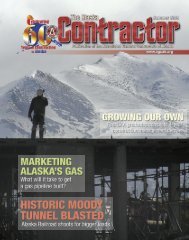The Alaska Contractor: Special 60th Anniversary Issue
The Alaska Contractor: Special 60th Anniversary Issue
The Alaska Contractor: Special 60th Anniversary Issue
You also want an ePaper? Increase the reach of your titles
YUMPU automatically turns print PDFs into web optimized ePapers that Google loves.
PH O TO: LA R RY MO O R E & ASSOCIATES<br />
By Ron Dalby<br />
As a young lawyer, Dan Cuddyʼs only banking experience was knowing that<br />
his father owned one. <strong>The</strong>n one day in 1951, his father died unexpectedly. <strong>The</strong><br />
next day Cuddy became president of First National Bank<br />
<strong>Alaska</strong>, which then boasted about $25 million in assets.<br />
It was the fi rst and only banking job he has ever held. He<br />
jokes today about never having been promoted.<br />
He learned fast and well. Today, Cuddy is still at the<br />
helm and the bank is worth more than $2.3 billion. And,<br />
of the 21 banks and savings and loans institutions that<br />
were operating in Anchorage in the mid-1980s, First National<br />
is the only one still in existence.<br />
<strong>The</strong> contractors’ banker<br />
In many respects Cuddy is known as the banker<br />
who helped contractors build <strong>Alaska</strong>. And while he appreciates<br />
the thought, he notes it’s really a symbiotic<br />
relationship.<br />
“It’s a two-way street,” Cuddy said. “<strong>The</strong> contractors<br />
built our bank. You can say that we’re the contractors’<br />
banker … we’re proud to be their banker. But it was the<br />
contractors’ support that made our bank what it is and<br />
made our growth, especially in the ‘40s and ‘50s.<br />
“I’m proud to be a part of their [contractors] growth—<br />
pleased and honored to be part of it.”<br />
Keys to success<br />
Looking ahead to carrying the bank forward, Cuddy<br />
says, “It’s relatively simple. You have an idea of what your<br />
goals are. We have several:<br />
Safety of the depositors’ money; Service to the community<br />
to full extent of our deposits and capital account;<br />
and take care of our employees.<br />
“If we do these three things, the stockholders will<br />
be taken care of very amply. That’s the philosophy I installed<br />
nearly 60 years ago. It’s good today; it’ll be good<br />
60 years from now.”<br />
As part of that philosophy, Cuddy is not nearly as<br />
impressed by a master’s degree from Harvard as he is by<br />
a loan offi cer who has previously worked in the industry<br />
he services. “We tell our offi cers that it’s their job to get<br />
out and work with the industry,” he said.<br />
Cuddy uses his own experiences as an example.<br />
“My fi rst job in construction was when we started<br />
building Elmendorf,” he said. “We dug the foundations<br />
by hand with a No. 2 shovel. <strong>The</strong>n I graduated from dig-<br />
Dan Cuddy<br />
‘It was the contractors’<br />
support that made<br />
our bank what it is’<br />
ging trenches to being a concrete mixer.<br />
“We didn’t have Anchorage Sand and Gravel and the<br />
big cement trucks. We had little individual cement mixers<br />
and we poured the cement and gravel and water in<br />
at one time and mixed it all on site.”<br />
He also notes, with a certain amount of pride, that he<br />
was in high school at the time.<br />
“You’ve got to remember that in those years we didn’t<br />
have minimum wages and we didn’t have all those laws<br />
which prevent young people from being [near] moving<br />
equipment,” he said.<br />
“One of the best examples of that were the three<br />
salmon canneries in Anchorage, and all the high school<br />
and grade school kids went to work in the salmon canneries<br />
in the summer. You’d be paid 15, 20 cents an hour.<br />
But it kept all of them busy; they all had a job and they<br />
didn’t get in trouble.<br />
“Now you couldn’t possibly do that because you<br />
have to be 18 to work, plus you’d have to be 21 to work<br />
on machinery. And that’s too bad.”<br />
<strong>The</strong> 1964 earthquake<br />
Without a doubt, the construction industry’s greatest<br />
single local feat in the past half century has been<br />
rebuilding southcentral <strong>Alaska</strong> after the Good Friday<br />
shaker that destroyed Valdez and Seward, and wrecked<br />
much of Anchorage. Cuddy was there, and with his<br />
bank made a major contribution to getting <strong>Alaska</strong> back<br />
on its feet.<br />
“After the earthquake there was really great sadness<br />
in the community with people worrying about where<br />
they would go and the loss of jobs.”<br />
At the time the foundation and fi rst fl oor were in<br />
place for what would eventually become First National’s<br />
new building. Cuddy continues, “It struck me that this<br />
would be a fi ne time to tell the people of Anchorage<br />
that at least our bank was confi dent in the community.”<br />
Cuddy did that by announcing he was forging ahead<br />
with the construction of the new multi-story building.<br />
He also helped Walter Hickel with part of the fi nancing<br />
for the Hotel Captain Cook, another project created<br />
by another man of vision when Anchorage was in the<br />
depths of despair after the earthquake.<br />
16 <strong>The</strong> <strong>Alaska</strong> conTrAcTor <strong>60th</strong> <strong>Anniversary</strong> <strong>Issue</strong> 1948–2008

















